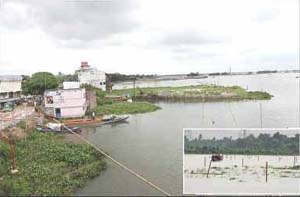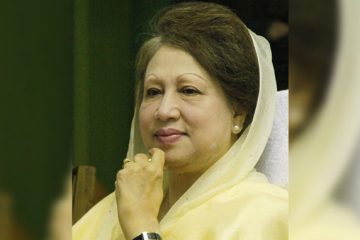Faulty demarcation encourages encroachers; ministerial recommendations for pillar relocation ignored
 The rivers of Dhaka are destined to remain narrow as the shipping ministry has expressed its inability to fully rectify the faulty demarcation of the streams despite a High Court order and subsequent ministerial decision.
The rivers of Dhaka are destined to remain narrow as the shipping ministry has expressed its inability to fully rectify the faulty demarcation of the streams despite a High Court order and subsequent ministerial decision.
An extensive visit revealed that relevant district administrations and officials of Bangladesh Inland Water Transport Authority (BIWTA) had demarcated the Turag, Balu and Buriganga rivers, leaving out the foreshores at many places.
As a result, land grabbers have embarked on massive river filling, cashing in on the foreshore exclusion at Sinnirtek, Amin Bazar and from Mirpur embankment to Ashulia along the Buriganga.
Shipping minister Shajahan Khan, who leads the national taskforce on river conservation, in reply to a question after a taskforce meeting on August 1 said the authorities had relocated most of the wrongly placed pillars along the Turag River.
“But we could not reclaim all the foreshores, as we had to give them up in many cases due to various reasons,” he said, adding, “We have requested the land ministry to take legal action against those responsible for the exclusion of the foreshores.”
The foreshore is the part of the shore between the lowest water level in the dry season and the highest level of water during the monsoon.
Shipping Secretary Abdul Mannan Howlader said, “We have repeatedly informed the land ministry of the anomaly in river demarcation, as it is the one to take legal action in this regard.
The national taskforce has no authority to compel a ministry to act, he said.
Sources said a section of unscrupulous officials had facilitated exclusion of foreshores during the demarcation in exchange for money.
One example of the gross destruction of the Balu is marking off a land-filling on a shoal in the middle of the river near Ichhapur Bridge as “private land”. The land has a boundary with pillars set up in an extremely irregular alignment.
River grabbing has also been going on at different locations, including one near Kamarpara Bridge along the Ashulia-Tongi embankment link road of the Turag.
The relevant authorities, however, have been silent about the earth-filling on such low-lying land, although the wetland conservation law prohibits such filling-up even on private land.
The district administrations of Dhaka and Gazipur along with the BIWTA have drawn the boundary line of the Turag, Balu and Buriganga during the dry season, excluding foreshore land in violation of a High Court order.
In 2009, the HC directed the deputy commissioners (DCs) concerned to demarcate the rivers as per Cadastral Survey (CS) and Revised Survey (RS), retaining the eroded areas and shoals and in order to protect them with pillars, walkways and plantations.
Now, with most of the foreshores left out, the government has to earth-fill into the rivers for walkways and trees, narrowing down the rivers further, said a BIWTA official.
They have neither followed the CS or RS records accordingly nor the definition of river, as outlined in the river port laws, said a BIWTA deputy director, who has worked extensively on the issue, wishing anonymity.
“They have only attempted to establish the lean water flow in the dry season as a river conveniently accommodating the anomalous leases and grabbing of foreshore lands,” he said.
Following reports on faulty demarcation, the government in May last year formed a committee headed by state minister for land Mostafizur Rahman. Subsequently the committee visited the Turag and Balu rivers.
It decided that the district administration along with BIWTA and directorate of land records had to resurvey and reset the pillars to demarcate the foreshores during monsoon high tide (August-September).
Rafiqul Islam, Dhaka river port officer, however, said they had relocated the pillars from Ashulia to Tongi in the right places.
When it was pointed out that pillars were still well into the river at many places, including in the Balu near Ichhapur Bridge, he said, “It may seem so to you, but it is actually not.”
Md Nurul Islam, deputy commissioner of Gazipur, said they had realigned the pillars along an 18-kilometre stretch but could not reclaim foreshore in all the cases.
“We tried to include foreshore with the river as much as possible. We hardly found land free as much as it should be,” he said, “I cannot readily say how foreshores were leased out to private individuals.”
Syeda Rizwana Hasan, chief executive of Bangladesh Environmental Lawyers Association (Bela), said excluding the foreshores in the process of saving rivers was a deviation of the HC order, as it would further shrink the rivers.
As per Land Management Manual, the district administration had no authority to lease out river foreshores, which is khas land, she said.
Courtesy of The Daily Star




















